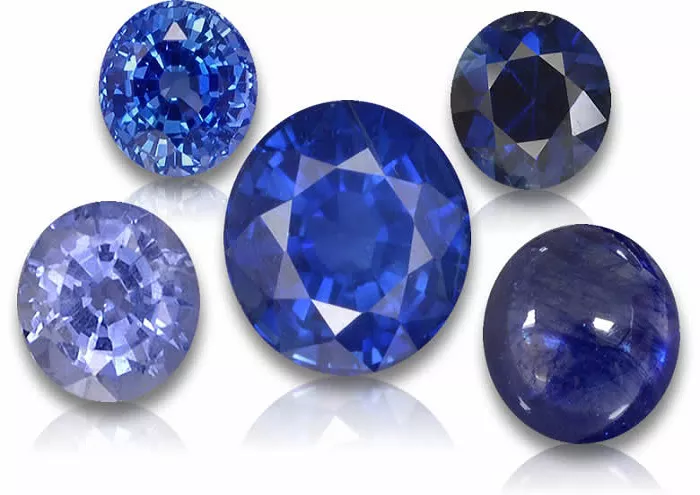Round blue sapphires are timeless gemstones cherished in fine jewelry. Their rich color, durability, and classic shape make them perfect for engagement rings, earrings, and necklaces.
This guide explores what makes round blue sapphires special, how they are graded, what affects their price, and how to choose the best one. Whether you’re buying for an engagement or as an investment, this information will help you make an informed decision.
What Is a Round Blue Sapphire?
A round blue sapphire is a variety of corundum, a mineral composed of aluminum oxide. While red corundum is called ruby, all other colors are sapphires. The blue color comes from trace elements like iron and titanium.
The round cut, also known as the brilliant cut, is the most traditional and versatile shape for gemstones. It has fifty-eight facets to maximize sparkle and a symmetrical design that enhances light reflection. This timeless shape suits all jewelry styles, making it a popular choice for blue sapphires.
How Blue Sapphires Get Their Color
Sapphires are not naturally blue on their own. Their color comes from trace elements in their crystal structure. Iron and titanium create the classic blue shades, with more iron resulting in darker tones and less iron producing lighter hues.
Some sapphires show color zoning, where the color appears uneven. High-quality sapphires have even color distribution.
The most sought-after shades include:
- Cornflower Blue – A medium blue with slight violet undertones.
- Royal Blue – A deep, vivid blue often found in Kashmir and Burmese sapphires.
- Teal Blue – A mix of blue and green, common in Sri Lankan sapphires.
- Light Blue – A soft, pastel tone popular in delicate jewelry.
How Sapphires Are Graded: The Four Cs
Like diamonds, sapphires are evaluated based on color, clarity, cut, and carat weight.
Color
Color is the most important factor in determining a sapphire’s value. Hue refers to the primary color, saturation measures the intensity, and tone describes how light or dark the blue appears. The most desirable sapphires have a vivid, medium-dark blue with no gray or green tints.
Clarity
Sapphires often contain natural inclusions, or internal imperfections. Eye-clean sapphires, which have no visible flaws, are the most valuable. Some inclusions, like silk, can enhance the stone’s appearance by creating a velvety glow.
Cut
A well-cut sapphire reflects light evenly, while a poor cut can make it look dull. Round sapphires should have good symmetry and polish to maximize brilliance.
Carat Weight
Sapphires are denser than diamonds, so a one-carat sapphire may appear slightly smaller. Prices increase significantly for stones over three carats, especially in high-quality grades.
Where Blue Sapphires Come From
The origin of a sapphire affects its color, rarity, and price.
Kashmir
Kashmir sapphires are known for their velvety blue hue and soft glow. Mining stopped in the 1920s, making these stones extremely rare and valuable.
Burma (Myanmar)
Burmese sapphires display a rich royal blue with high saturation. They are also rare and command high prices.
Ceylon (Sri Lanka)
Sri Lankan sapphires are bright and lively, often in cornflower blue. They are more affordable than Kashmir or Burmese stones.
Madagascar
Madagascar produces sapphires in cornflower to royal blue shades. They offer good value for their quality.
Australia and Thailand
These sapphires tend to be darker, sometimes inky, and are generally less expensive.
Treated vs. Untreated Sapphires
Most sapphires on the market undergo treatments to improve color and clarity.
Heat Treatment
This is the most common method, enhancing color and removing silk inclusions. Heat-treated sapphires are widely accepted if disclosed.
Diffusion Treatment
This adds a thin layer of color to the stone but is less stable and lowers value.
Beryllium Diffusion
This treatment alters the core color and is not recommended for investment-quality stones.
Natural, untreated sapphires are rare and cost significantly more than treated ones.
How Much Does a Round Blue Sapphire Cost?
Prices vary based on quality. Low-grade sapphires with dark tones or visible inclusions may cost between fifty and three hundred dollars per carat. Medium-quality stones with good color and slight inclusions range from three hundred to fifteen hundred dollars per carat. High-quality sapphires with vivid blue color and eye-clean clarity can cost fifteen hundred to ten thousand dollars per carat. The rarest, such as untreated Kashmir sapphires, can exceed ten thousand dollars per carat.
How to Choose the Best Round Blue Sapphire
Prioritize Color
Look for a vivid, medium-dark blue without gray or green undertones.
Check Clarity
Ensure the stone is eye-clean with no visible black spots.
Examine the Cut
The sapphire should reflect light evenly without dark areas.
Verify Certification
Always request a gem lab report from reputable sources like GIA or AGL.
Compare Prices
Buy from trusted dealers with return policies to avoid scams.
Blue Sapphire vs. Diamond: Which Is Better?
Sapphire Advantages
- Unique color that stands out.
- More affordable per carat for high-quality stones.
- Symbolizes royalty, wisdom, and loyalty.
Diamond Advantages
- Higher brilliance and sparkle.
- Slightly harder on the Mohs scale.
- Traditional choice for engagement rings.
The best choice depends on personal preference—sapphires offer rich color, while diamonds provide unmatched sparkle.
Caring for Your Blue Sapphire Jewelry
Clean sapphires with warm soapy water and avoid harsh chemicals. Store them separately to prevent scratches. Check ring prongs annually for security, and avoid ultrasonic cleaners if the stone has fractures.
Conclusion
Round blue sapphires are classic, durable, and stunning. They work beautifully in engagement rings, earrings, and investment pieces. Before purchasing, always check the quality factors, request certification, and compare sellers.
With the right choice, a blue sapphire can become a treasured heirloom. Whether you prefer the royal blue of Kashmir or the bright cornflower hues of Ceylon, this gemstone offers timeless elegance.
Related Topics:
- Where Do Kentucky Blue Sapphires Come From?
- Where is Sapphire Blue Hole?
- Is Sapphire Scratch-Resistant? Everything You Need to Know


